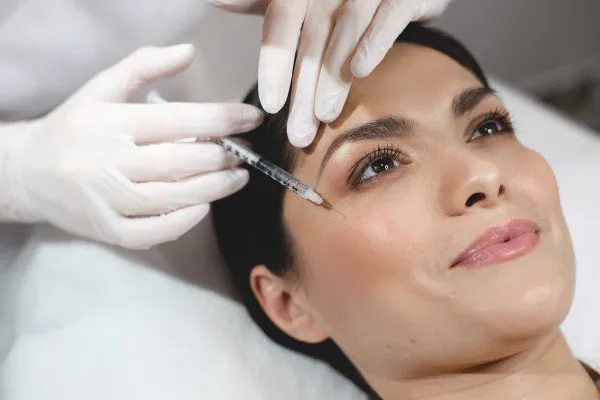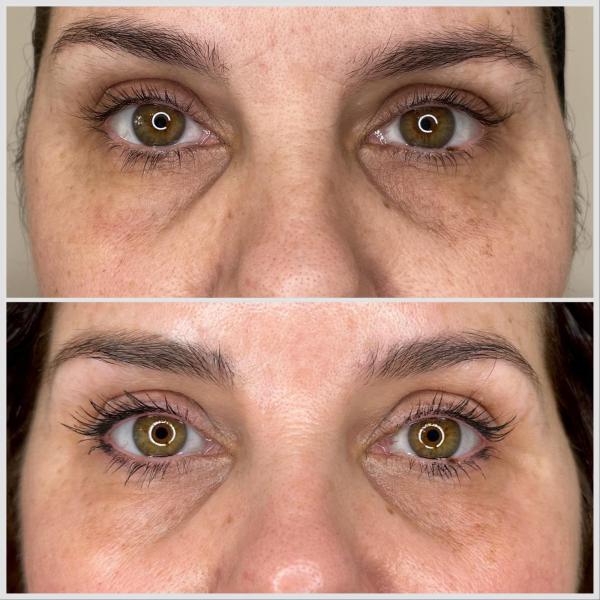
Dark circles: Polynucleotides Case Study
Dr Amy Law shares a case study treating dark circles with polynucleotides in a 50-year-old female patient
Infraorbital dark circles represent a common and multifactorial challenge in aesthetic practice.1 “Dark circles” is not a formal medical term but a widely used term that collectively indicates symptoms of dark areas under the eyes.2

The delicate skin around the eyes is prone to various factors that contribute to the development of dark circles.1,4 Common factors include:
- Hyperpigmentation: Excessive melanin production in the periorbital area can lead to pigmented dark circles. This can result from genetics, sun exposure, or post-inflammatory hyperpigmentation. Infra-orbital dark circles are more common in patients with allergic conditions such as atopic dermatitis or allergic contact dermatitis, where rubbing the area causes post-inflammatory hyperpigmentation (PIH) around the eyes.2
- Vascular issues: Dilated blood vessels beneath the thin skin around the eyes can contribute to a bluish tint. Factors such as poor circulation, fatigue, and hereditary predisposition can exacerbate vascular-related dark circles.5
- Volume loss: Age-related loss of fat and collagen in the under-eye area can create a hollow appearance, known as the “tear trough”, casting shadows and intensifying the appearance of dark circles.2,6
- Skin thinning and wrinkling: The skin around the eyes is delicate and prone to thinning over time, revealing the underlying blood vessels and contributing to the overall appearance of dark circles.1
Dark circles can significantly impact an individual’s perceived attractiveness and overall facial aesthetic, with patients reporting they make them look tired, older and even sad.1-4
Treatment options
Addressing infraorbital dark circles necessitates a tailored, multidimensional approach. Commonly utilised treatment modalities may include topical treatments, dermal fillers, peels, laser and light-based treatments and even surgery.1 Polynucleotides are now presenting a new option for aesthetic practitioners.7
Case study
A 50-year-old female patient came into the clinic concerned about her dark circles, which she said she had had since she was young. She complained of never being able to leave the house without wearing concealer and said that the dark circles made her feel really “old” and “tired”.
She wanted to find out what her options were because filler hadn’t worked for her in the past. In addition, because she had a history of fluctuating puffiness throughout the day, we agreed that filler wasn’t the way forward and that we needed to explore other options to improve the problem.
On assessment, she had quite deep pigmentation underneath the eyes, a fairly deep teardrop hollow, and slightly poor skin laxity. The main issue for me was the pigmentation, so managing her expectations was extremely important as you don’t always know what level of improvement you’ll get periorbitally.
I felt polynucleotides could work for her, but I couldn’t charge her
for a treatment where I couldn’t predict the outcome, so I said, “We can provide this treatment for you at no charge. We would just love to see what results you get. If it works, we’d love to potentially show this and publish it.” She was really on board with that.
We used Plinest Eye with anti-radical complex (a treatment that helps counter free radicals and brightens and awakens skin and tissue) for the first three sessions, and she really started to see an improvement from that. At the fourth session, we used Plinest Eye without the anti-radical complex. I kept the appointments at four-week intervals.
For the first two sessions, I used a 25G 40-millimetre cannula in the tear trough (deep and superficial). Then, I did intradermal blebs around the periorbital region and the upper and lower periorbital regions. With the anti-radical complex, I treated that intradermally. I did 0.2mls in the medial tear trough under the orbicularis oris muscle. Then I did 0.2mls above the muscle and 0.1mls into the lateral groove below the muscle and 0.1mls above the muscle. I did a 0.4ml intradermal bleb underneath the eye, bringing it over superorbitally as well. Then, I used the anti-radical complex. I placed 0.6mls under each eye and across the periorbital region intradermally, and for the remaining 3.4mls, I placed intradermally across the face.
In the third session, I used the Plinest intradermally. In the fourth session, I used the Plinest Eye intradermally, micro-bolusing it around underneath the eye and above the eye.
It took about four months to complete treatment. I reviewed her six weeks after her last session, and she had seen a huge, huge improvement. I would probably say from her third session, we really started seeing improvement in the under-eye hollow, the brightening effect underneath the eye, and the improvement in skin quality.

To maintain her results, I gave her the Obagi Professional-C 10% vitamin D serum, and she’s been using that throughout. I also asked her to use a Heliocare SPF every day, and she’s been continuing to use it. I advised her to come back between six and nine months for just one booster session with the Plinest underneath the eye.
She was over the moon. There was still some pigmentation, and she obviously still had an under-eye hollow, but it was much less significant than it was when she initially presented. The fact that she said she could now go out without any concealer on and wasn’t self-conscious about it showed that it made a massive improvement to her quality of life and her overall confidence.
One thing she also mentioned was the anti-radical complex really helped improve her skin texture, brightness and hydration. She really rated the anti-radical complex and really saw an improvement. Overall, she was really, really pleased with the results.
Conclusion
Infraorbital dark circles pose a significant cosmetic challenge, but polynucleotides are now offering a new and effective way to treat them.
References
- Vrcek, Ivan & Ozgur, Omar & Nakra, Tanuj. (2016). Infraorbital Dark Circles: A Review of the Pathogenesis, Evaluation and Treatment. Journal of Cutaneous and Aesthetic Surgery. 9. 65. 10.4103/0974-2077.184046.
- Park KY, Kwon HJ, Youn CS, Seo SJ, Kim MN. Treatments of Infra-Orbital Dark Circles by Various Etiologies. Ann Dermatol. 2018 Oct;30(5):522-528. doi: 10.5021/ad.2018.30.5.522. Epub 2018 Aug 28. PMID: 33911473; PMCID: PMC7992473.
- Nguyen HT, Isaacowitz DM, Rubin PA. Age and fatigue related markers of human faces An eye tracking study. Ophthalmology. 2009 116 355 60.
- Freitag FM, Cestari TF. What causes dark circles under the eyes? J Cosmet Dermatol. 2007 Sep;6(3):211-5. doi: 10.1111/j.1473-2165.2007.00324.x. PMID: 17760701.
- Huang YL, Chang SL, Ma L, Lee MC, Hu S. Clinical analysis and classification of dark eye circle. Int J Dermatol. 2014 Feb;53(2):164-70. doi: 10.1111/j.1365-4632.2012.05701.x. Epub 2013 Jul 24. PMID: 23879616.
- Haddock NT, Saadeh PB, Boutros S, Thorne CH. The tear trough and lid/cheek junction: anatomy and implications for surgical correction. Plast Reconstr Surg. 2009;123:1332–1340. discussion 1341-1342
- Cavallini M, Bartoletti E, Maioli L, Massirone A, Pia Palmieri I, Papagni M, Priori M, Trocchi G. Consensus report on the use of PN-HPT™ (polynucleotides highly purified technology) in aesthetic medicine. J Cosmet Dermatol. 2021 Mar;20(3):922-928.